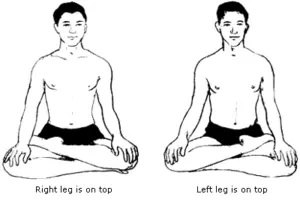 The Lotus Position (Sanskrit: पद्मासन [pɐd̪mɑːs̪ɐn̪ɐ], IAST: padmāsana) is a cross-legged sitting asana originating in meditative practices of ancient India, in which the feet are placed on the opposing thighs. It is an established asana, commonly used for meditation, in the Hindu Yoga, Jain, and Buddhist contemplative traditions. The asana is said to resemble a lotus, to encourage breathing proper to associated meditative practice, and to foster physical stability.
The Lotus Position (Sanskrit: पद्मासन [pɐd̪mɑːs̪ɐn̪ɐ], IAST: padmāsana) is a cross-legged sitting asana originating in meditative practices of ancient India, in which the feet are placed on the opposing thighs. It is an established asana, commonly used for meditation, in the Hindu Yoga, Jain, and Buddhist contemplative traditions. The asana is said to resemble a lotus, to encourage breathing proper to associated meditative practice, and to foster physical stability.
Shiva, the meditating ascetic God of Hinduism, Siddhartha Gautama, the founder of Buddhism, and the Jinas of Jainism have been depicted in the lotus position.
From the common sitting down on the floor (Indian Style, Cross-legged) position (asana), one foot is placed on top of the opposite thigh with its sole facing upward and heel close to the abdomen. The other foot is then lifted up slowly and placed on the opposite thigh in a symmetrical way.
The knees are in contact with the ground. The torso is placed in balance and alignment such that the spinal column supports it with minimal muscular effort. The torso is centered above the hips. To relax the head and neck, the jaw is allowed to fall towards the neck and the back of the neck to lengthen. The shoulders move backward and the ribcage lifts. The tongue rests on the roof of the mouth. The hands may rest on the knees in the chin or jnana mudra. The arms are relaxed with the elbows slightly bent.
The eyes may be closed, the body relaxed, with the awareness of the overall asana. Adjustments are made until balance and alignment are experienced. Alignment that creates relaxation is indicative of a suitable position for the asana. The asana should be natural and comfortable, without any sharp pains.
In most cases, a cushion (zafu) or mat (zabuton) is necessary in order to achieve this balance. One sits on the forward edge of the cushion or mat in order to incline one’s pelvis forward, making it possible to center the spine and provide the necessary support. Only the most flexible people can achieve this asana without support under their pelvis (and likewise does The Dalai Lama explicitly advise).
